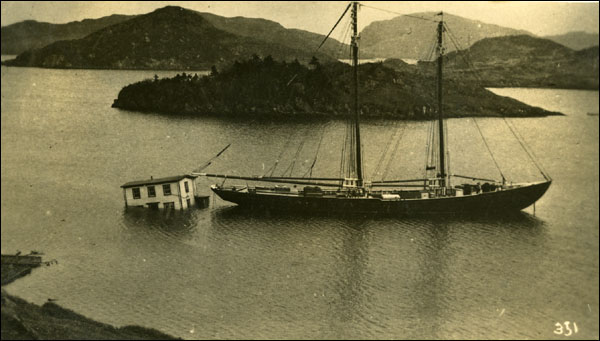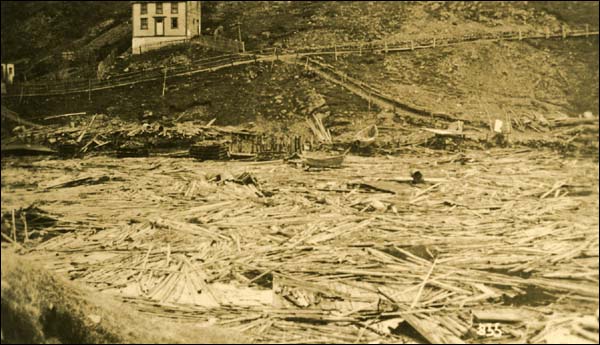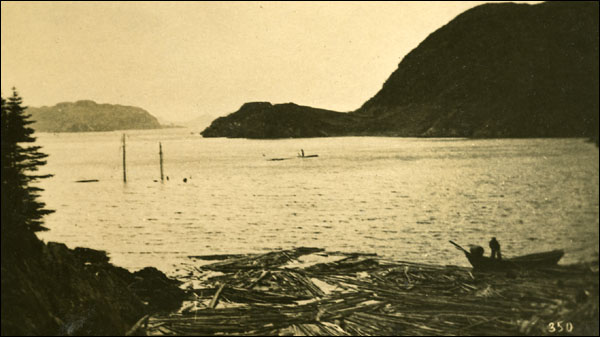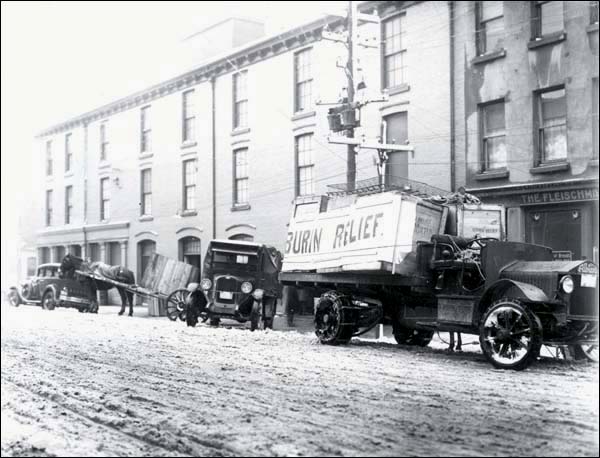Public Response to the 1929 Tsunami
The tsunami left the people of the affected communities on the Burin Peninsula in desperate need of help. When news of the disaster finally did reach St. John’s on 21 November, the government and public were quick to respond. A relief ship arrived at the Burin Peninsula the following day carrying medical equipment, food, clothes, and other supplies. Public donations poured in from across the country, and within weeks amounted to $250,000. Canada, the United States, and Britain also gave money and aid. Despite these efforts, the start of the Great Depression in 1929 and the collapse of the cod fishery in the early 1930s further damaged the Burin Peninsula’s weakened economy; it was not until the 1940s that many communities were able to fully recover, while others could not recover at all.

Immediate Response
Once the tsunami passed, survivors turned their attention to helping the wounded and to salvaging food, clothes, and other belongings from the wrecked buildings and debris lining the shoreline. They used any remaining boats to search for victims swept out to sea or trapped in houses floating on the water. When sea levels returned to normal, many survivors discovered they had lost their homes, fishing gear, and other possessions. More tragic was the discoveries of missing relatives or neighbours. Cut off from the outside world, survivors had to share all available shelter and food and hope that help would arrive soon. However, overcrowding became a problem in some communities where few houses had survived the tsunami; at Taylor’s Bay, between 18 and 20 residents crowded into each of the settlement’s five remaining homes. Compounding the situation was a snow storm which arrived on the peninsula the morning after the tsunami.

Despite these hardships, many survivors worked tirelessly to help the wounded and less fortunate. Nurse Dorothy Cherry of Lamaline, for example, travelled by horse and then on foot to numerous communities between her home village and Burin to treat the sick and injured. The Newfoundland and Labrador government later presented Cherry with a $250-cheque in recognition of her efforts. The crew of the SS Daisy, which was docked at Burin during the disaster, also did much to help communities by salvaging houses, boats, and other structures floating along the coast. In the days following the disaster, the ship’s crew saved thousands of dollars’ worth of property.
Word Reaches St. John’s
Once word of the disaster reached St. John’s on 21 November, government officials took immediate action. Prime Minister Sir Richard Squires dispatched the steamer SS Meigle to the Burin Peninsula with a cargo of medical supplies and personnel, government officials, food, clothing, construction materials, and other goods.

The vessel departed St. John’s harbour on the night of 21 November and arrived at Burin the following afternoon. For five days the relief crew steamed up and down the Burin Peninsula, delivering aid and surveying the damage. At Point au Gaul, government officials were shocked to learn that the tsunami had destroyed 100 buildings and all of the community’s 40 dories and motor boats. St. Lawrence had also lost all of its motor boats during the tsunami, as well as every flake and fishing stage. Living conditions were particularly poor at Taylor’s Bay, where only five houses survived the disaster; aid workers provided the village with 10,000 feet of lumber to rebuild, as well as large quantities of coal and clothing.
Relief workers departed the Burin Peninsula on the morning of Wednesday, November 27, and arrived at St. John’s that afternoon. In their report to the government, expedition members estimated that the tsunami had caused more than $1 million in property damage and destroyed all of the boats and fishing gear belonging to half of the peninsula’s wage earners.
South Coast Disaster Committee
While the Meigle was delivering aid to the Burin Peninsula, government officials and prominent citizens at St. John’s established the South Coast Disaster Committee to coordinate fundraising and other relief efforts. Within weeks of its formation, the committee had collected $100,000 from St. John’s and $90,000 from Corner Brook, Grand Falls, and smaller settlements across the country. Many people who could not afford to donate money gave food, clothes, and other items. As news of the disaster spread, $50,000 also arrived from Canada, the United States and Britain.

Alongside collecting funds, the South Coast Disaster Committee also provided tsunami victims with food, clothing, fishing gear, and construction materials to rebuild damaged houses and replace boats, flakes, and other structures. It also paid out compensation for tsunami-related deaths or injuries, but did not reimburse communities for any winter food stores they lost in the disaster; this included the 127,000 kilograms of salt cod that were destroyed by the tsunami and worth approximately $30,000.
Despite relief efforts, the following decade was a time of tremendous economic hardship for many communities along the Burin Peninsula. Compounding the effects of the tsunami were the beginning of a worldwide depression in 1929 and the collapse of the cod fishery in the early 1930s. Although many settlements were able to rebound during the 1940s, when the Second World War brought much economic prosperity to Newfoundland and Labrador, others, such as Taylor’s Bay, continued to decline.




